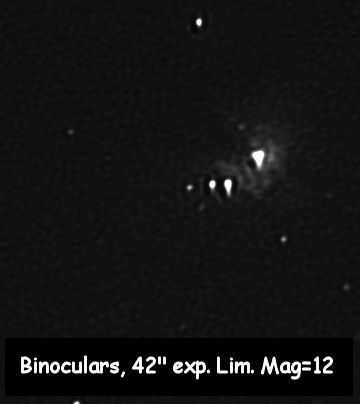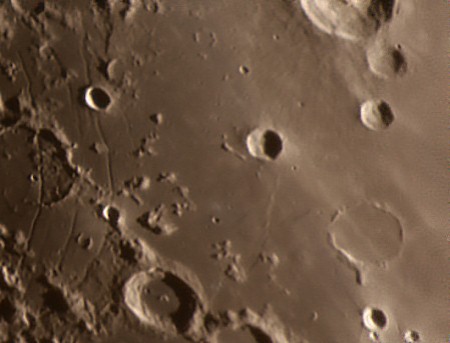Near Bullialdus crater (at top-right side of the picture) there is a quite interesting region called Rimae Hippalus. Hippalus crater is the big one (left-center side of the picture). It is a big crater. In this image, shadows in this crater due to a low altitude sunlight creates a visual effect, as if a great creature had stamped his bare footprint in lunar soil. Do you see it?
Archive for no tracking
Moon scratched by the claw of a bear
Posted in Astrophotography with tags Astronomy, Astrophotography, Bullialdus crater, Canon EOS 450D, Manual-Crazy-Tracking, Meade Lightbridge 16", Moon, Newtonian, no tracking, Reflex, Registax, Rimae Hippalus, Telescope on 2011/08/31 by computerphysicslabPolaris A & Polaris B
Posted in Astrophotography with tags afocal, Astronomy, Canon EOS 450D, Deep sky, Newtonian, no tracking, Polaris, Polaris A, Polaris B, Rebel XTi, Reflex on 2009/10/18 by computerphysicslabPolaris has a close neighbor at 18 arcseconds that can be spotted easily through a telescope.

This is a 15 seconds exposure through a Meade Lightbridge 16-inch, a Dobson with no tracking, but fortunately Polaris moves very slowly through its small circumpolar path, due to its proximity to north pole in the sky. The camera used was a Canon EOS 450d, also known as Rebel XTi. The method employed was an eyepiece projection using a 14mm Meade Series 5000.
Auriga and Moonlight
Posted in Astrophotography with tags Astronomy, Auriga, Canon EOS 450D, constellation, Moon, no tracking, Rebel XTi, Reflex, shift-and-add on 2009/10/10 by computerphysicslabThis is a set of 71 single shots of 10 seconds each one to the Auriga constellation on 2009-10-08. The Moon was located at its south and its brightness is visible on the edge of the image and on the background gradient. The single frames were recorded using a Canon Rebel XTi (EOS 450d) and a conventional EF 18mm lens. The Kids is a triangle of stars on the upper side of Auriga constellation.

Reaching Binocular focus
Posted in Astrophotography with tags afocal, Astronomy, Binocular, blur, Moon, no tracking, sharp on 2009/09/29 by computerphysicslabSomeone asked me for help recently using this comment:
“Hello, I have 16×50 binoculars and a 7.1 mega pixel camera with 4x zoom and I’ve done what you said and looked at the Moon and the images are no where near as close as yours. The image blurs once the picture is taken of the moon and doesn’t seem no where near as close to the moon as yours. Please help.”
I would like to share the answer just in case someone is also interested.
Answer:
16x and 4x should mean a final 64x optical zoom. That is as much as when seeing through a telescope. If you are capturing frames at 7 MegaPixels this is to say they are around 3,000×2,500 pixels in size. When creating a video you need a final image size of 1,000×700 as much, so if you crop a frame of 3,000×2,500 into a final frame of 1,000×700, it would be equivalent to apply a 3x additional zoom to the image, because (1,000×700) * 3 is more o less equal to 3,000×2,500.
Bottom line: do a crop to your 7 Mpx image and you will get an effective 182x magnification.
Respecting the blur, don’t panic. The blur may be a product of the weather conditions, or a thermal issue in your binoculars.
Try to avoid make photos of the Moon when it is located directly over the roof of a neighbour. This is a very frequent source of blurring problems.
Try also to cool down your binoculars before the observation, trying to get a thermal equilibrium with the outdoor temperature.
Be sure that your digicam is functioning with a infinite focus mode. The focus must be achieved manually using the binocular focuser.
If you have the option of taking continuous shots, use it. The majority of the images recorded may be blurred, but sometimes you may get one more clear and sharp.
Well. I hope this helps you to get sharper images.
Good luck.
Jupiter, Io & Wesley impact scar
Posted in Astrophotography with tags 150/750, afocal, Astronomy, Canon EOS 450D, impact, Jupiter, Newtonian, no tracking, Paint Shop Pro, Registax, scar, shift-and-add, Telescope, Wesley on 2009/08/28 by computerphysicslabGood seeing yesterday too (2009-08-27 23h05m UT). Wesley impact scar is fading day after day, but it is still there. I made an animation that shows Io approaching Jupiter’s limb: http://www.youtube.com/watch?v=78zJtv569y4

Big Jupo
Posted in Astrophotography with tags 150/750, afocal, Astronomy, Canon EOS 450D, EOS Camera Movie Record, Jupiter, Mitchell, Newtonian, no tracking, Paint Shop Pro, Photoshop, Rebel XTi, Reflector, Reflex, resampling, shift-and-add, Telescope, VirtualDub on 2009/08/27 by computerphysicslabI have a good seeing last night. So I got my best Jupiter yet. Here it is:

It is 4x resampled via Registax Mitchell and PS. After resampled I can spot more details in bands and polar zones.
As always I used the 6-inch no-EQ mounted newtonian reflector, the 14mm eyepiece doing afocal projection over the Canon EOS 450d (Rebel XTi) body and recording video using “EOS Camera Movie Record” free software. Three times Jupiter crossed over the field of view. Registax and VirtualDub added and stacked the footage properly.
M42 with point & shoot digicam
Posted in Astrophotography with tags afocal, Astronomy, Binocular, Casio Exilim EX-Z80, digicam, M42, no tracking, Orion, point & shoot, shift-and-add, Vixen 12x80 on 2009/08/26 by computerphysicslabIt is interesting to explore the possibilities of some common devices such as digicams and binoculars. I have been reprocessing some old stuff from March. I took 474 single exposures of M42 in Orion through the binoculars with my Exilim digicam. Using a stacking software, all these subframes may become aligned and added accurately, resulting into a 4 minutes long exposure single shot with a perfect star-tracking. I reckon I didn’t use any kind of equatorial mount or motorized tracking. Just an steady tripod. Orion belt passed accros the field of view of the binoculars 3 times. In every gap, I corrected manually the FOV to get M42 inside it as longest as possible.
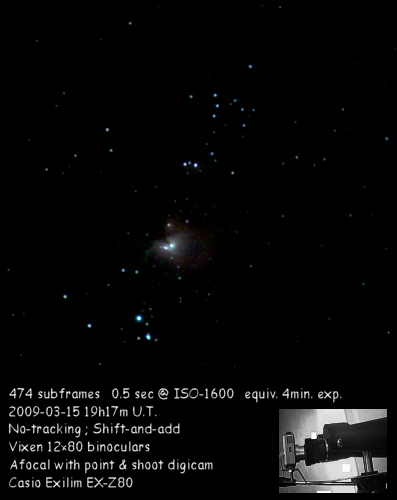
Ganymede’s shadow
Posted in Astrophotography with tags 150/750, afocal, Astronomy, Canon EOS 450D, Europa, Ganymede, Io, Jupiter, moons, Newtonian, no tracking, Paint Shop Pro, Photoshop, planet, Rebel XTi, shadow, shift-and-add on 2009/08/20 by computerphysicslabYesterday night I had the chance to enjoy a multiple moon transition in Jupiter. Ganymede and Europa were crossing Jupiter and throwing their shadows to the big planet. Here it is an image of the event. At 23h 24m U.T Europa’s shadow was not visible yet. Io also appears at the photo but it was beneath the planet. In a minutes it would disappear.
The picture was taken with my digital reflex body (EOS Rebel XTi) and using the video capture software that converts it into a high quality webcam.
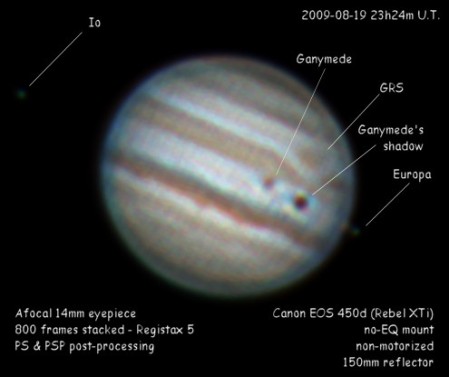
Jupiter Opposition
Posted in Astrophotography with tags 150/750, afocal, Canon EOS 450D, Jupiter, Newtonian, no tracking, Opposition, Paint Shop Pro, Photoshop, Rebel XTi, Reflector, Reflex, shift-and-add, Telescope on 2009/08/17 by computerphysicslab15th August 2009 was the day that Jupiter reached its closest position to Earth. Its apparent diameter was 49 arcseconds, so this is the best time to do planetary astrophotography with the giant planet. Using the afocal technique and a Canon EOS 450d body I took 2 video sequences and processed with Registax 5, Photoshop & Pain Shop Pro.
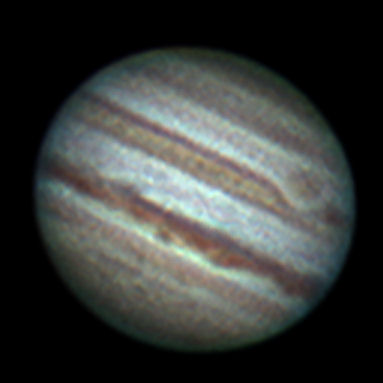
Wesley impact scar
Posted in Astrophotography with tags 150/750, afocal, Astronomy, Canon EOS 450D, GRS, Jupiter, Newtonian, no tracking, Photoshop, Rebel XTi, scar, shift-and-add, Wesley impact on 2009/08/16 by computerphysicslabSeveral days ago a comet hit Jupiter leaving a dark spot near one of its polar regions. Today this spot is still visible with a powerful telescope. Maybe if I have a high power Barlow lens I could have observed it visually. But fortunately there exist astrophotography, a technique that lets you observer indirectly what you can’t spot directly through a telescope.
In this same picture I include a Jupiter from the day before yesterday. The lack of atmospheric turbulence gave me a chance to get closer to the maximum theoretical resolution of a 6-inch telescope.

Jupiter selection & post-processing
Posted in Astrophotography with tags afocal, Astronomy, Canon EOS 450D, Jupiter, Newtonian, no tracking, post-processing, shift-and-add, Telescope on 2009/08/12 by computerphysicslabYesterday I took several videos with Canon EOS 450d (Rebel XTi) to Jupiter through the no-EQ mounted 150mm reflector. The final effective resolution of every video is slightly different, depending on the weather conditions and the focus reached in this precise instant. So I have chosen the two best sequential videos and appended each other into one final with double frame size.
After selecting and appending, I used Photoshop to apply a hard sharpen, and several other filters getting different final results. Here they are.

Jupiter & 3 moons
Posted in Astrophotography with tags 150/750, afocal, Canon EOS 450D, Jupiter, Newtonian, no tracking, Registax, shift-and-add, Telescope on 2009/08/12 by computerphysicslabJust some minutes ago.
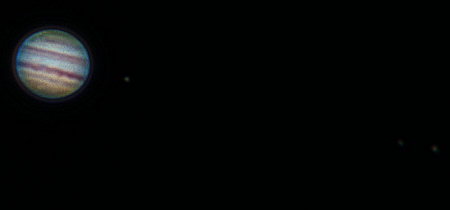
Hommel crater
Posted in Astrophotography with tags 150/750, afocal, Asclepi, Casio Exilim EX-FS10, crater, digicam, Hommel, Moon, Nearch, Newtonian, no tracking, Paint Shop Pro, Photoshop, Pitiscus, point-and-shoot, shift-and-add, Telescope on 2009/08/10 by computerphysicslabHommel is a big crater with nice craterlets inside, a Clavius-style set, but smaller, measuring 76 miles (129 Km). It is located in the South-East area of the visible Moon face. This area is pledge of small craters. It is similar in appearance to the sand of a beach. Pitiscus, Nearch and Asclepi are some of its neighbors.
The picture was taken at 19 days of lunation, that is 4 days after full Moon. This is the best timing to get sharp images of the crater’s walls’ shadows. The image is an integration of 27 subframes, each one taken at 9 Megapixels single shots with point-and-shoot digicam Casio Exilim EX-FS10.

Mare Crisium & Tranquillitatis
Posted in Astrophotography with tags 150/750, afocal, Astronomy, Canon EOS 450D, Lu, Mare Crisium, Mare Tranquillitatis, Moon, Newtonian, no tracking, Paint Shop Pro, Proclus, Rebel XTi, Reflex, Registax, shift-and-add, Telescope on 2009/08/08 by computerphysicslabTwo days after full moon Mare Crisium shows a nice landscape of mountains and shadows. Some of its inner crates are visible in this picture. The small crater Swift is on the limit of visibility. The big impact called Proclus and its rays are remarkable.
To take this image I used the Canon EOS 450d, Rebel XTI DSLR camera recording video subframes and later I stacked them up with Registax 5. Some small tweaks on Paint Shop Pro 9 and ready.
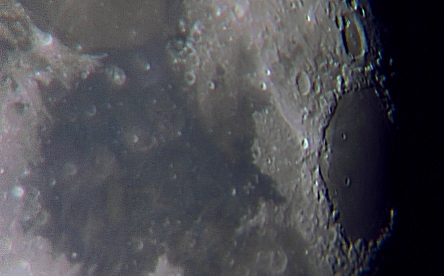
Full Moon
Posted in Astrophotography with tags 150/750, Astronomy, Canon EOS 450D, Canon EOS Rebel XTi, Full Moon, Newtonian, no tracking, Reflex, Registax, saturation, shift-and-add, Telescope on 2009/08/06 by computerphysicslabIn order to catch the Moon, I took 4 single shots at prime focus through my 150/600 telescope. As I lack of a T-mount adapter I had to take them in handheld mode. After de-rotating them accordingly, I stacked them up with Registax 5 and removed the noise a little bit. I used the body camera Canon EOS 450d (Rebel XTi) at high resolution, low sensitivity (ISO 100) and high shutter speed 1/2000. This is the result after a blow up in saturation:

Io’s shadow over Jupiter
Posted in Astrophotography with tags 150/750, afocal, Astronomy, Canon EOS 450D, Io, Jupiter, no tracking, Paint Shop Pro, Registax, shift-and-add, Telescope on 2009/08/05 by computerphysicslabAs Io passes in front of Jupiter, a big shadow is cast over the planet. In this picture I took tonight, it is clearly visible the dark point of shadow in the dead center of Jupiter. At its right a small spot that you may barely watch is Io.

In order to get a sharp image I used a Van Citter deconvolution process.
Jupiter occultation of 45 Cap
Posted in Astrophotography with tags 150/750, 45 Cap, afocal, Astronomy, Bright star, Casio Exilim EX-FS10, Jupiter, Newtonian, no tracking, occultation, Registax, shift-and-add, Telescope on 2009/08/04 by computerphysicslabJupiter occultation of 45 Cap tonight:
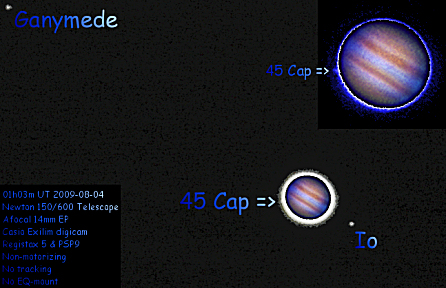
Jupiter with Exilim, 450d & Webcam
Posted in Astrophotography with tags 14mm, 150/750, afocal, Astronomy, Canon EOS 450D, Casio Exilim EX-FS10, Eyepiece, GRS, Jupiter, Newtonian, no tracking, Philips, Rebel XTi, Registax, shift-and-add, Telescope, ToUcam Pro, webcam on 2009/08/03 by computerphysicslabHere I have integrated my best images of Jupiter taken with 3 different cameras:
* Casio Exilim EX-FS10
* Canon EOS 450D (Rebel XTi)
* Webcam Philips ToUcam Pro
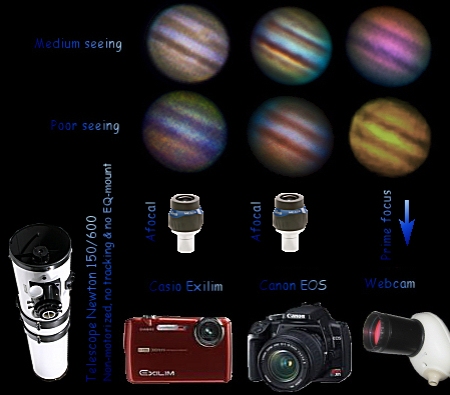
Jupiter post-processing
Posted in Astrophotography with tags afocal, Astronomy, Casio Exilim EX-FS10, good seeing, Great Red Spot, GRS, Jupiter, Newtonian, no tracking, Paint Shop Pro, Registax, shift-and-add, Telescope on 2009/07/29 by computerphysicslabI have been lucky tonight. Good seeing to see Jupiter. Using a small binoculars between the eyepiece and my eye I could spot visually Jupiter in high definition at an effective 450x magnification. That’s pretty good for a 150/600 reflector, isn’t it?
As you may appreciate in the following picture, the GRS (Great Red Spot) is clearly visible near the center of the planet. Several details are visible in the Jupiter’s bands. The image was obtained with a non-tracking Newtonian 6-inch telescope, a 14mm eyepiece, a Casio Exilim EX-FS10 digital camera that recorded 165 subframes. Registax 5 dealt with the alignment and stacking process. Dyadic Wavelets were applied to get contrast and details. PSP9 did the post-processing. The footage was taken exactly at 2009-07-28 03:33 UT.
Here several post-processing results are shown. The first one is that I like more.
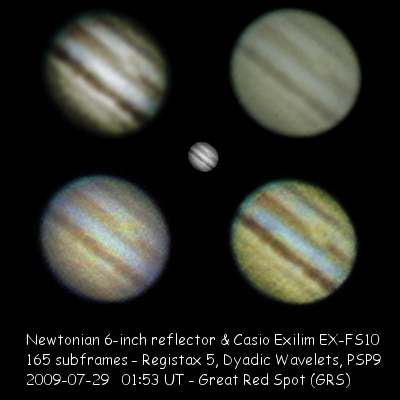
Jupiter, Europa & Ganymede
Posted in Astrophotography with tags afocal, Astronomy, Casio Exilim EX-FS10, Europa, Ganymede, Jupiter, no tracking, shift-and-add, Telescope on 2009/07/28 by computerphysicslabHere it is, Jupiter, Europa & Ganymede.

My best Jupiter so far
Posted in Astrophotography with tags 6 inches, Astronomy, Jupiter, Newtonian, no tracking, Philips Toucam Pro, Reflector, shift-and-add, Telescope, wavelets, webcam on 2009/07/26 by computerphysicslabMy 6-inch reflector working over a photographic tripod, and a webcam recording the focal plane. This is the resulting image, once overprocessed, yes, I give you that.
With Registax 5 I stacked 150 subframes and then applied dyadic wavelets. Some retouching with Paint Shop Pro 9 and fractal zooming under Photoshop.
The footage corresponds to 2009-07-26 at 01:44 UT.
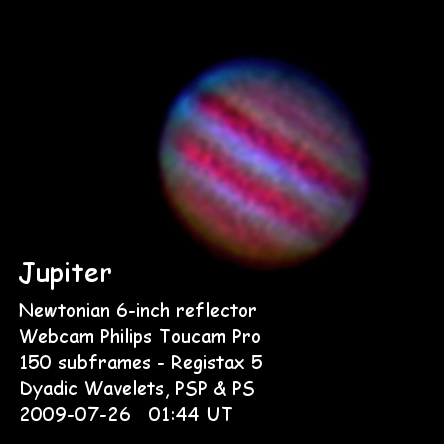
Jupiter’s galilean moons
Posted in Astrophotography with tags afocal, Callisto, Casio Exilim EX-FS10, Europa, Galilean moons, Ganymede, Io, Jupiter, no tracking, Registax, satellites, shift-and-add on 2009/07/22 by computerphysicslabGalilean moons are very easy to observe using some kind of instrument to get some magnification. With just a binoculars would be enough to spot the four moons of Jupiter. They are constantly rotating around Jupiter. Every day their relative distances and positions changes. Their names are Io, Callisto, Europa & Ganymede. They all have a similar size and brightness. When passing in front of the big planet, they cast a shadow over the gaseous surface of Jupiter. It is required a telescope to observe such events.
Here it is a picture I took tonight with a digital pocket camera through a 14mm eyepiece and a 150 mm newtonian reflector telescope with no-tracking system.
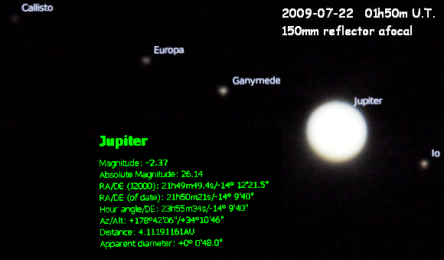
Light Pollution
Posted in Astrophotography with tags batch processor, Canon EOS 450D, dark frame, Deep sky, DeepSkyStacker, DSLR, image arithmetic, light pollution, no tracking, Paint Shop Pro 9, shift-and-add on 2009/07/21 by computerphysicslabLight pollution in suburban skies makes nearly impossible astrophotography. Nevertheless, there exists some computer techniques to make it possible. I have used a dark frame to catch the exact pattern of the light pollution in the photographed area. The way to accomplish this is not difficult. Shooting in continuous mode the DSLR camera facing the zenith in my home window, and forcing every frame to last 15 seconds I got a sequence of subframes to be processed afterward.
To get the dark frame I do some image arithmetic with Paint Shop Pro 9: I choose 3 or 4 distant subframes and compute them using “darkest” option. This way, stars become to fade until disappearing.
With Paint Shop Pro 9 and batch processor I apply a barrel lens distortion of 17 (empirical value to correct a 18mm focal lens like Canon’s) to every subframe and also to the dark frame.
Once got the dark frame DeepSkyStacker is needed to stack the single subframes and substract the dark frame. The sideral drift of the field is automatically compensated with the intelligent algorithm that DeepSkyStacker provides.
The resulting image is surprising taking into account this is an urban sky.

From a light polluted city
Posted in Astrophotography with tags Aquila, Canon EOS 450D, light pollution, Lyra, Milky Way, Nebulosity 2, no tracking, urban sky, widefield on 2009/07/19 by computerphysicslabThis image was taken in the center of a light polluted city with almost 1 million inhabitants. Using a dark frame of the polluted sky I could catch the Milky Way. Obviously it was impossible to observe it with naked eye.
The image is the result of adding 20 subframes of 15 seconds of exposure each one at ISO 1600. After applying a barrel distortion filter to compensate lens distortion the images become integrable. Using Nebulosity 2 software I could compensate the sideral motion of the sky.
The quality of the image is very low. The point here is not quality but the successful of avoiding light pollution in a widefield Milky Way shot. The area corresponds to the border of Lyra constellation towards Aquila constellation.

Bullialdus area
Posted in Astrophotography with tags afocal, Bullialdus, Casio Exilim EX-Z80, Meade Lightbridge 16", Moon, no tracking, Pitatus, Promontorium Taenarium, Rükl plate 53 & 54, Registax, Rupes Recta on 2009/07/18 by computerphysicslabA lot of features are located in this area of the Moon. Some of them are: Rupes Recta, Pitatus, Promontorium Taenarium, Bullialdus. It corresponds to the area covered by the Rükl plates 53 & 54.
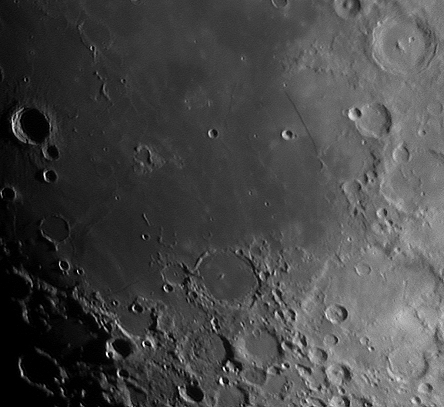
Bullialdus is the big crater at upper left side, in the shadows. Pitatus is centered in the lower side. Inside several details are visible: a peak and an inner rim. Rupus Recta is the large straight wall on the right side.
This picture was obtained after stacking (with Registax 5) 20 single frames taken with Casio Exilim pocket digital camera in afocal projection through an eyepiece using a Meade Lightbridge 16-inch dobsonian telescope.
Canon EF-S 18-55mm barrel distortion
Posted in Astrophotography with tags Canon EF-S 18-55mm, field curvature, lens, no tracking, shift-and-add on 2009/05/19 by computerphysicslabIn order to stack non-tracking subframes for widefield astrophotography, it is important to get images with no field curvature. My lens Canon EF-S 18-55mm when working at lowest zoom, that is 18mm of focal, presents a clear barrel distortion as reported in the image below. Nevertheless, it can be corrected applying a pincushion lens distortion of 15 in Paint Shop Pro. But the image border remains distorted so it is needed a crop reducing the image to an 80% of its original size.
Of course, the best solution is to stop using the 18 mm focal length for shift-and-add astrophotography. Instead longer focal is advisable like 35 mm, where the lens does not show any significant distortion in the field of view.
Another advice to get a sharp focus and pinpoint stars with Canon EF-S 18-55mm lens is to always use a focal ratio no less than F:5 and no more than F:10. Under F:5 the lens coma aberration would mess the stars near the image border and over F:10 the diffraction would create big Airy patterns instead of pinpoint stars.

I have said above that “it is important to get images with no field curvature to do shift-and-add astrophotography”. I must correct it. Sky pictures are not like an image of a wall. A wall is a plane surface, but the sky is not. Actually, the sky is an sphere, the celestial sphere, that is constantly rotating around Polaris. So, the correct way to add images is not converting them to plane field, but to spherical field in the right proportion.
I have told you that pincushion lens distortion corrects the field. That is truth, but it is not appropriated to process non-tracking subframes. The subframes must firstly be corrected to show an spherical field. So the right filter to apply is indeed a barrel lens distortion, increasing this way the natural barrel that comes with the lens.
It is easy to verify this, just trying to overlap 2 distant subframes. The first and the last of the session may be optimal. Only after applying a barrel of 17 in Paint Shop Pro I could overlap successfully the subframes, preserving angles and distances between stars.
A bit better Saturn
Posted in Astrophotography with tags afocal, Casio Exilim EX-FS10, Dione, Meade Lightbridge 16", no tracking, Registax, Rhea, satellite, Saturn, Telescope, Titan on 2009/05/16 by computerphysicslabFortunately, yesterday was not cloudy and I could do further experiments with Saturn. Using a Barlow 2x and Casio Exilim EX-FS10 camera I filmed some videos at highest resolution through the big dobsonian telescope Meade Lightbridge 16-inch. Weather conditions were good. I did a better collimation than previous days, getting sharp focus from time to time. Stacking the frames with Registax 5 I got this resulting image:

In the left side of the image, it is visible a satellite of Saturn. It is Titan, with 9 magnitude. Over it, a bit at right there is almost visible another one, Rhea of magnitude 10. Visually it was observable another one aligned to Titan and Rhea, but it is not visible in the image. It was Dione with 11 magnitude.
Luckily this image shows the gap between foreside ring and its rear part. The image effective resolution according to my calculations is 1 arcsecond. Two cloud bands are visible one in the north hemisphere and the other in the south.
I would like to break the 1 arcsecond resolution barrier, but I don’t know if it is possible with this telescope. Theoretically it delivers a 0.3 arcsecond resolution because it has 400mm of mirror diameter.
Meade Lightbridge smoothness
Posted in Astrophotography with tags Dobsonian, Meade Lightbridge 16", Newtonian, no tracking, Reflector, Telescope on 2009/05/05 by computerphysicslabHi CPL,
Thanks for posting that cool vid of the 16″ Lightbridge. I just spoke with someone at a telescope store who said they were looking to get rid of their 12″ Lightbridge because they said it is very shaky when viewing, and gives an unstable image.
I just was in a shop which had an 8″ Lightbridge and I would describe it as very smooth and rock solid.
Can I ask you if you’ve had any shaky or bouncing issues with your 16″?
I’m thinking of the 12″ for myself!
Thanks, PK
—————————————————————————————-
Meade Lighbridge does not come with slow motions for altazimuth movements. If you compare the movement of the Lightbridge with that of a tripod mounted refractor, for example, probably the tripod mounted is going to be much precise.
Nevertheless, it depends too much on what kind of observation are you planning. Watching the Moon, Lightbridge may became very smooth and exact in movement, because you always have a bright lunar surface all over the field of view and the movement you apply to the optical tube is constantly compared to the drift as seen through the eyepiece. On extensive deep sky objects, the same happens. The most difficult objects to track are planets, because the surrounding field of view is pitchblack and you lose any references once the planet gets out of the field.
If you try to use high power eyepieces with small apparent field of view with a planet, the lack of equatorial mount and a sideral motor drive may become a nightmare. In this cases, my advice is to always use widefield eyepieces and reduce the magnification if necessary.
To get a smooth movement it is important to balance correctly the optical tube, adding some magnets at the bottom side of the tube, near the mirror. Do not forget to check that the base of the dobsonian mount is not tilted. Following these advices, the telescope will have a very smooth movement in both axis, as shown in my video at http://www.youtube.com/watch?v=WWUGCk0wN24
The tracking becomes more difficult as longer the focal length. So Meade Lightbridge 16″ is the most difficult to track, because a slight movement in your hands transforms in a great movement in the field. Lower aperture telescopes, have less focal distance and apparent movements in the field are smoother.
If you are planning the use of the telescope for observational purposes, you won’t have any problems with the smoothness of the tracking once you get trained in several sessions. If you plan to do astrophotography, dobsonian movement may become a problem. Nevertheless, I do astrophotography of Moon, planets, and stars through my Meade Lightbridge 16″. You may check it out at my webpage: https://computerphysicslab.wordpress.com/
My final advice is: if you have previously be using regularly a smaller scope doing astronomy, you won’t find any problem using any of Meade Lightbridge series. Collimation is an important point to deal with in this scopes, but the quality of its elements is superb, and the price is really good.
Proclus and surroundings
Posted in Astrophotography with tags afocal, Casio Exilim EX-Z80, Mare Crisium, Mare Tranquillitatis, Meade Lightbridge 16", no tracking, Proclus, Registax, shift-and-add on 2009/05/02 by computerphysicslabStacked from a video under Registax 5 and stitched with Autostitch, I got yesterday this Moon mosaic. Equipment: Meade Lightbridge 16″ and Casio Exilim EX-FS10.
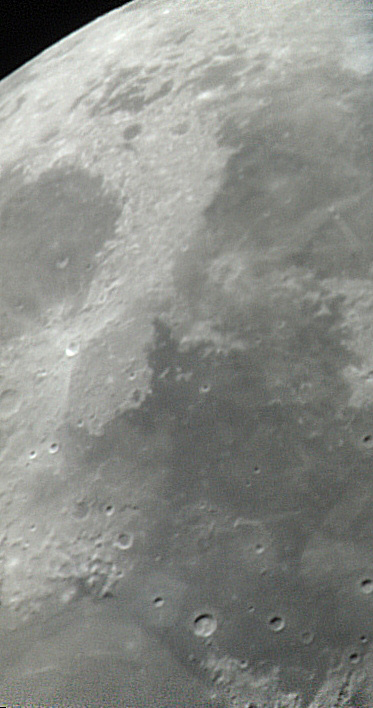
Waxing Gibbous Moon
Posted in Astrophotography with tags afocal, Binocular, Casio Exilim EX-Z80, Gibbous, Moon, Nebulosity 2, no tracking, Paint Shop Pro, phase, Registax, shift-and-add, Vixen 12x80 on 2009/04/08 by computerphysicslabYesterday’s Moon in phase waxing gibbous as seen through the Vixen 12×80 binocular, here it is. Registax 5 stacked 55 individual frames of 8 Mpx each. Nebulosity 2 was used to compensate the sideral movement and perform the de-rotation. Sharpening with Paint Shop Pro.
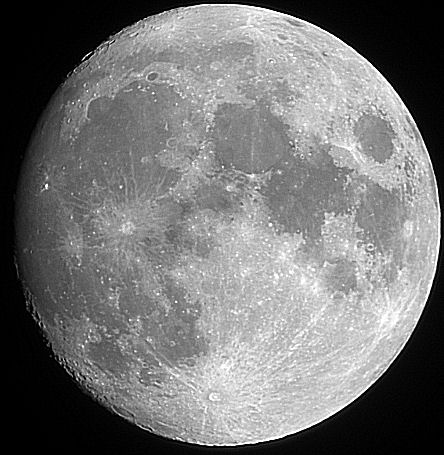
Copernicus Crater
Posted in Astrophotography with tags afocal, AutoStitch, Casio Exilim EX-Z80, lunation, Meade Lightbridge 16", Moon, no tracking, Registax, terminator on 2009/04/04 by computerphysicslabCopernicus is the name of a big Lunar crater. A video taken with the compact digital camera and the Meade Dobsonian was processed using Registax, and the resulting three frames were stitched with AutoStitch. We see here a zone in the terminator for a 9 lunation days Moon around Copernicus:
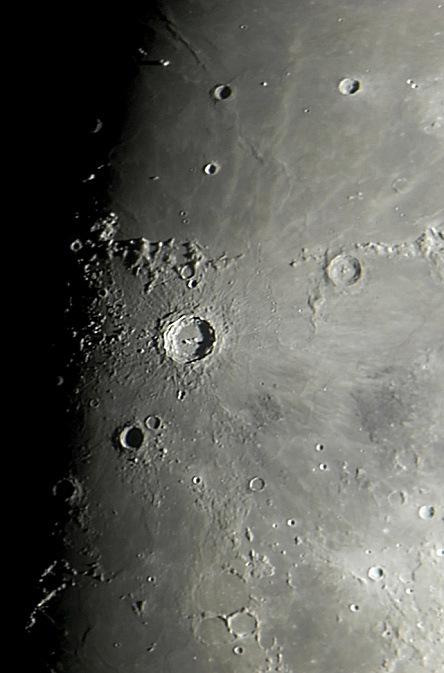
Mizar & Alcor
Posted in Astrophotography with tags afocal, Alcor, Big Dipper, Casio Exilim EX-Z80, dobsonian reflector, double star, Meade Lightbridge 16", Mizar, no tracking, shift-and-add, Sidus Ludoviciana, Ursa Major on 2009/03/24 by computerphysicslabMizar and Alcor are probably the most well known double star in the sky. Located in Ursa Major,it is very easy to separate Mizar from Alcor, even with the unaided eye.
Sidus Ludoviciana is the faint star between Mizar and Alcor. Mizar is the brightest one, which in fact is a binary system: Mizar A & B, with an angular separation of 14 arcseconds.
Photo taken with the dobsonian reflector Meade Lightbridge 16″, using afocal eyepiece proyection. Here we see 222 shots of 0.5 seconds of exposure stacked. No tracking, shift-and-add method.
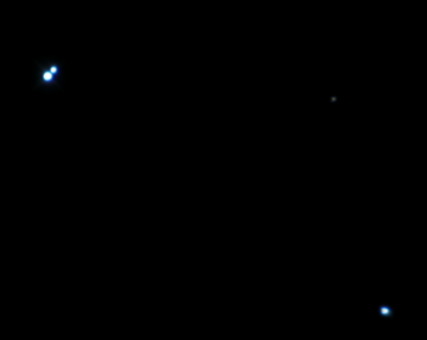
M42 last night
Posted in Astrophotography with tags Binocular, Casio Exilim EX-Z80, Great Nebula of Orion, M42, Manaluna Observatory, Messier Marathon, no tracking, Orion, shift-and-add, Trapezium, Vixen 12x80 on 2009/03/21 by computerphysicslabLast night I could enjoy a really clear night sky at Manaluna Observatory. Meanwhile some of my partners were working hard to complete the Messier Marathon, I took 3 series of no-tracking shots through Vixen 12×80 binocular to M42 in Orion.
The truth is that what I could see through binoculars was much more brilliant and detailed than the next image by far. I think my Casio Exilim digital pocket camera is a bit insensible to dim light …
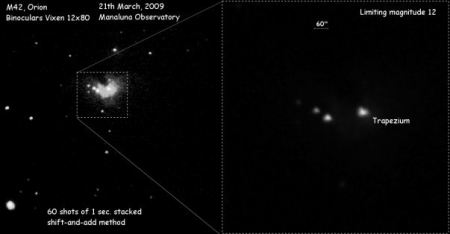
Trapezium is visible as a spot. The 20″ separation among its components is too close for my binoculars to resolve it. Remember that 20″ is the apparent diameter of Saturn.
M42 through binoculars
Posted in Astrophotography with tags Binocular, Great Nebula of Orion, M42, no tracking, shift-and-add, Vixen 12x80 on 2009/03/09 by computerphysicslabM42 is the brightest nebula in the sky. It becomes visible even under light polluted urban skies. I took some exposures of M42, the Great Nebula of Orion, using my Vixen 12×80 binoculars and stacked them up. No tracking, even manual. Just shift-and-add method. This is the result; up to magnitude 12 stars are visible and the core of the nebula is also evident:
